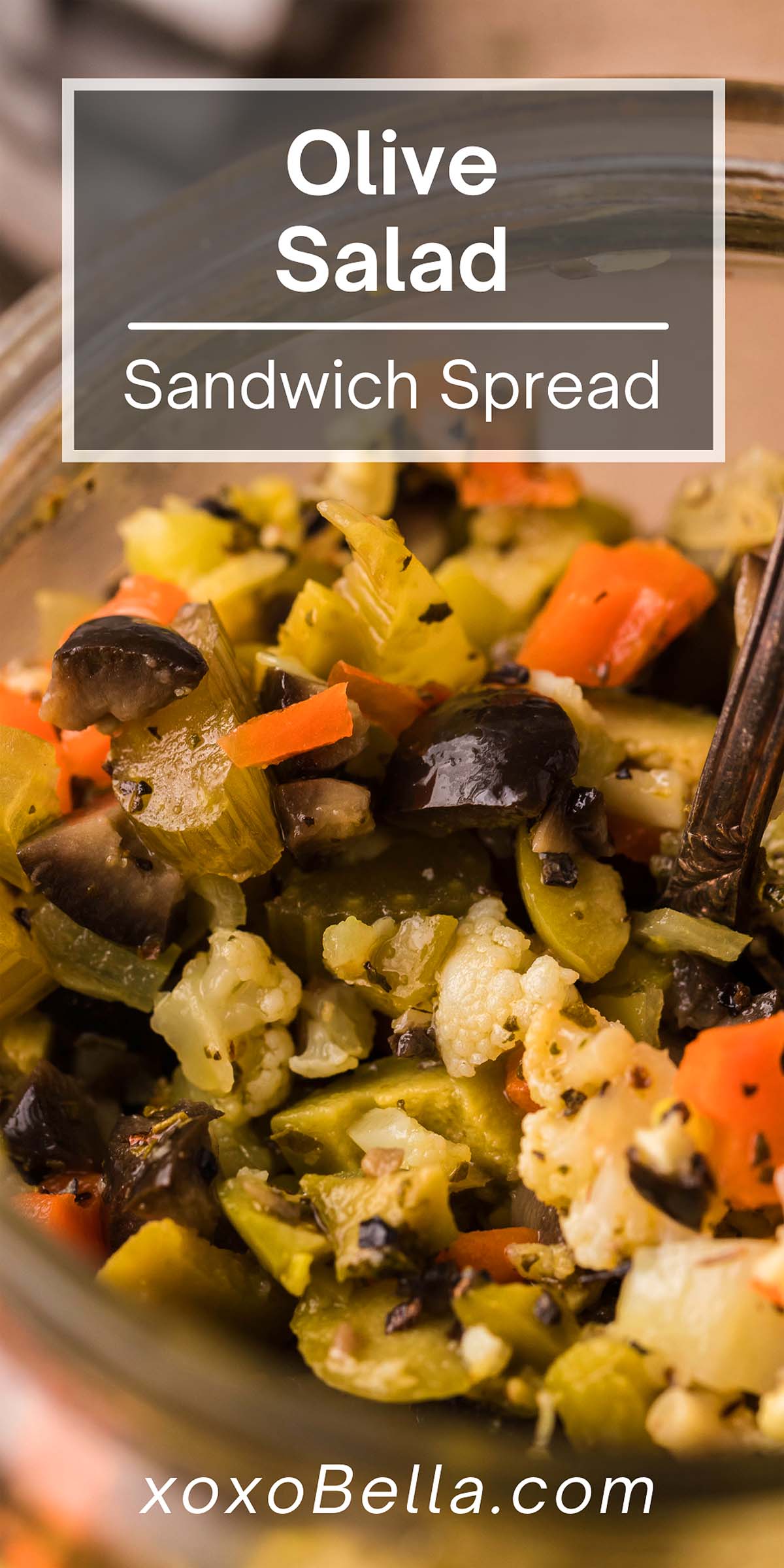
Easy Olive Salad for Muffaletta Recipe: A Classic
Olive salad for muffuletta recipe is a flavorful mix of olives, pickled vegetables, and herbs. Essential for an authentic New Orleans sandwich experience.
Equipment
- Chopping Board
- Chef's knife
- Measuring cups and spoons
- Large Mixing Bowl
- Garlic press (optional)
- Plastic Wrap or Airtight Container (for storage)
Ingredients
- 1 cup pitted green olives, coarsely chopped (such as Castelvetrano)
- 1 cup pitted black olives, coarsely chopped (such as Kalamata)
- 1 cup giardiniera, drained and coarsely chopped
- 1/2 cup celery, finely chopped
- 1/4 cup pickled carrots, finely chopped
- 1/4 cup fresh parsley, chopped
- 2 tablespoons fresh oregano, chopped
- 2 cloves garlic, minced
- 1/2 cup extra virgin olive oil
- 2 tablespoons red wine vinegar
- 1 teaspoon dried oregano
- 1/2 teaspoon black pepper
- 1/4 teaspoon red pepper flakes (optional)
Instructions
- Step 1: Prepare the Olives: Coarsely chop the green and black olives. Ensure the pits have been removed before chopping. Consistent sizing helps in uniform flavor distribution.
- Step 2: Chop the Vegetables: Finely chop the giardiniera, celery, and pickled carrots. Smaller pieces integrate more effectively and release their flavors uniformly.
- Step 3: Mince the Aromatics: Mince the garlic cloves. Chopping the parsley and oregano finely ensures their flavors infuse the olive oil.
- Step 4: Combine Ingredients: In a large bowl, combine the chopped olives, giardiniera, celery, pickled carrots, parsley, oregano, and minced garlic. A non-reactive bowl is best to prevent any unwanted flavors from leaching into the salad.
- Step 5: Dress the Salad: Pour in the extra virgin olive oil and red wine vinegar. Sprinkle in the dried oregano, black pepper, and red pepper flakes (if using). The red pepper flakes add a subtle heat.
- Step 6: Mix Thoroughly: Toss all the ingredients together until well combined, ensuring that the olive oil coats everything evenly. This step is essential for flavor melding.
- Step 7: Marinate: Cover the bowl tightly with plastic wrap and refrigerate for at least 4 hours, or preferably overnight. This allows the flavors to meld and intensify.
- Step 8: Serve: Before serving, allow the olive salad to come to room temperature for about 30 minutes. This helps to release the full flavor profile. Serve on a muffuletta sandwich or as a topping for bruschetta. Optional Tips: For a spicier salad, add a pinch more red pepper flakes or a dash of hot sauce. If you prefer a milder flavor, rinse the olives and giardiniera before chopping to reduce their saltiness and acidity. You can also substitute capers for some of the olives for an extra briny flavor. For an intense garlic flavor roast garlic before minced.
Notes
Variations
The olive salad for muffuletta recipe can be adapted to suit diverse tastes and dietary needs.
- Ingredient Swaps: Instead of standard giardiniera, consider using homemade pickled vegetables with cauliflower, carrots, and celery. Capers or pepperoncini peppers can add an extra layer of briny or spicy flavor. Varying the olives by incorporating green Cerignola olives or Nicoise olives can also alter the flavor profile.
- Regional Twists: A Sicilian version might include roasted red peppers or eggplant. A spicier Calabrian adaptation could incorporate Calabrian chili peppers or a drizzle of chili oil. Each regional twist offers a unique variation on the classic recipe.
- Dietary Adjustments: For a lower-sodium version, rinsing the olives and pickled vegetables before chopping helps reduce salt content. To make it vegan, ensure the giardiniera does not contain any animal-derived ingredients, which can sometimes be found in commercially prepared versions.
Serving Suggestions
Olive salad is most famously served as a key component of the muffuletta sandwich, layered between sliced meats and cheeses on a large, round loaf of bread. However, its versatility extends beyond this classic application. It can be served as an antipasto with crusty bread or crackers, as a topping for bruschetta, or as a flavorful addition to pasta salads. It also pairs well with grilled meats or fish, adding a tangy and briny element to the meal. The olive salad is ideal for gatherings, picnics, or any occasion where a flavorful and easy-to-serve dish is desired.
Storage Tips
To preserve freshness, olive salad should be stored in an airtight container in the refrigerator. Properly stored, it will maintain its quality for up to one week. The olive oil will solidify in the refrigerator, so it is recommended to bring the salad to room temperature for about 30 minutes before serving to restore its optimal texture and flavor. Freezing is not recommended, as it can alter the texture of the olives and vegetables.
Frequently Asked Questions
- Question 1: Can the olive salad be made ahead of time?
Yes, in fact, it is recommended. Marinating the salad for at least 4 hours, or preferably overnight, allows the flavors to meld and intensify. - Question 2: Can other vegetables be added to the salad?
Certainly. Experimenting with different pickled vegetables or fresh vegetables, such as roasted red peppers, is encouraged to customize the flavor profile. - Question 3: How can the saltiness of the salad be reduced?
Rinsing the olives and giardiniera before chopping helps to reduce their salt content. Using lower-sodium pickled vegetables is another effective approach. - Question 4: Is it necessary to use fresh herbs?
While fresh herbs are preferred for their vibrant flavor, dried herbs can be substituted. Use about half the amount of dried herbs as fresh herbs, as their flavor is more concentrated.